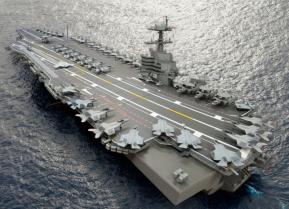The Navy's Most Powerful Aircraft Carrier Ever is 50% Complete
The USS Kennedy will replace the USS Nimitz which is due to retire by 2027; the Ford-class carriers are slated to replace the existing Nimitz-class carriers on a one-to-one basis in an incremental fashion over the next fifty years or so.
A shipboard illuminator is an RF signal that bounces off a target. The antenna in the nose in the guidance section [of the missile] sees the reflected energy and then corrects to intercept that reflective energy, Raytheon officials told Warrior.
The emerging missile has an “active” front end, meaning it can send an electromagnetic signal forward to track a maneuvering target, at times without needing a ship-based illuminator for guidance.
Also, the missile is able to intercept threats that are close to the surface by sea-skimming or diving in onto a target from a higher altitude, Navy officials explained.
Phalanx Close in Weapons System
The Phalanx Close in Weapons System, or CIWS, is an area weapon engineered to use a high rate of fire and ammunition to blanket a given area, destroying or knocking enemy fire out of the sky before it can reach a ship. The Phalanx CIWS, which can fire up to 4,500 rounds per minute, has been protecting ship platforms for decades.
CWIS firs a 20 mm Vulcan cannon mounted on a swiveling base. An essay in Naval Forces magazine called "CIWS - the Last Ditch Defense," further specifics that the weapon fires "armor piercing tungsten penetrater rounds with discarding sabots." CIWS fires a M61A1 Gatling gun out to ranges of 3 km.
In previous interviews, Navy officials have told Warrior Maven that the latest CIWS Block IB provides ships the additional capability for defense against asymmetric threats such as small, high speed, maneuvering surface craft, slow-flying fixed and rotary-winged aircraft, and unmanned aerial vehicles.
A CIWS overhaul in recent years has consisted of numerous upgrades to the weapon itself, converting the existing systems into what's called the Phalanx 1B configuration. At the same time, the CIWS overhaul also includes the development and ongoing integration of a new, next-generation radar for the system called the CIWS Phalanx Block IB Baseline 2, Navy officials explained.
The Phalanx Block IB configuration incorporates a stabilized Forward-Looking Infra-Red sensor, an automatic acquisition video tracker, optimized gun barrels (OBG) and the Enhanced Lethality Cartridges (ELC).
The FLIR also improves performance against anti-ship cruise missiles by providing more accurate angle tracking information to the fire control computer.
The OGB/ELC combine to provide tighter dispersion and increased first hit range, a Navy official added. The Phalanx 1B fires Mk 244 ammunition, using the Enhanced Lethality Cartridge specifically designed to penetrate anti-ship cruise missiles.
The Mk 244 ammunition is engineered with a 48 percent heavier tungsten penetrator and an aluminum nose piece, according to information from General Dynamics Ordnance and Tactical Systems.
The Phalanx Block IB Baseline 2 radar upgrade is a new digital radar that provides improved detection performance, increased reliability and reduction in sailor man-hours for system maintenance, developers said.
The Baseline 2 upgrade mitigates obsolete components inherent in the existing analog radar by introducing COTS-based (commercial off-the-shelf) signal processing coupled with a new signal source and mixer.
CIWS uses "Ku-band radar featuring closed-loop spotting technology capable of autonomously performing its own search, detect, evaluation, track, engage and kill assessment functions," a Naval Forces essay writes.
The Baseline 2 radar also provides the Phalanx CIWS with "surface mode," meaning it adds the ability to track, detect and then destroy threats closer to the surface of the water compared with previous models of the weapon, developers explained.
This first appeared in Warrior Maven here.

